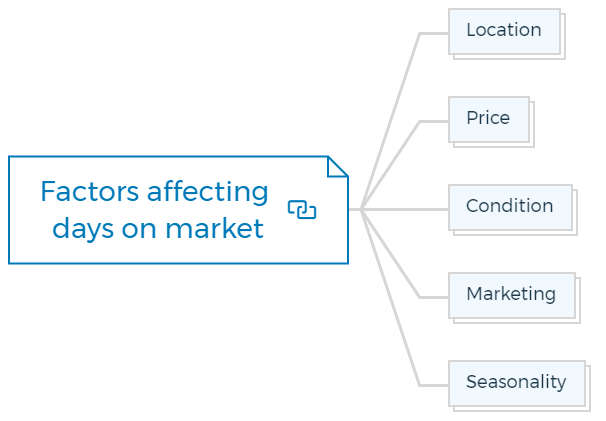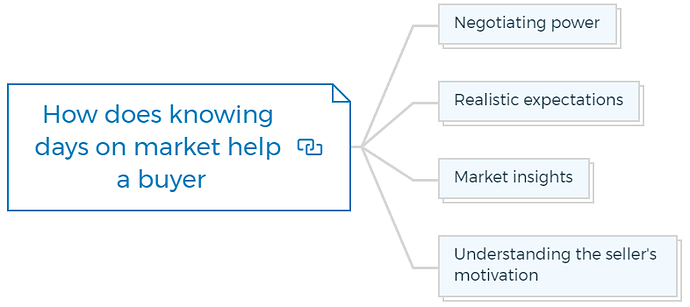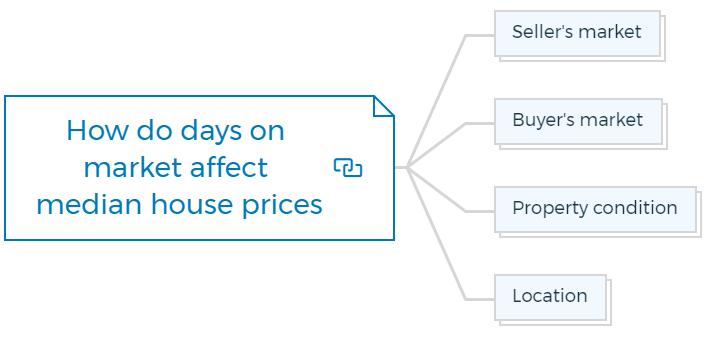Days on market: How long does it take for a home to sell?
One of the essential tools of strategic planning is to cross-check the demand on the property the owner has raised. Is the property actually worth it or not? You can check it through Days on Market.
For instance, the number of days a property sits on the Market judges its position and the demand. The greater the number of days a property sits on the Market, the lesser the demand for the property.
Let’s understand the concept of Days on Market in detail.
What is days on market (DOM)?
Days on Market (DOM) measures how long a property is on the Market before being sold or withdrawn. DOM is usually computed from the day the property is listed on the Multiple Listing Service (MLS) until it is sold or off the Market.
Days on Market (DOM) is a crucial real estate metric that quantifies how long a property is listed before being sold. Typically, a shorter DOM means higher demand for properties in that area, as they are being quickly sold.
On the other hand, a longer DOM may suggest less demand when the property is not drawing enough purchasers and is on the Market for a lengthy time.
Buyers may view a house with a high DOM as undesirable or costly. However, a reduced DOM can increase buyer urgency, demand, and prices.
I have explained the concept in more detail by taking examples of Berwick and Frankston data in the above video. If you are a property investor or an upcoming property developer, understanding how to use Days on the Market in your development journey is a must.
You are missing out if you haven’t yet subscribed to our YouTube channel.
What should be the ideal DOM?
When purchasing or selling a property, days on Market (DOM) might reveal local property demand. A DOM of fewer than 50 indicates a hot market with great demand and fast sales. However, a DOM over 90 may imply a cool market with weaker demand and lengthier sales times.
The buyer’s goals determine the property’s ideal DOM. If someone is looking to buy a property in a hot market with high demand, a DOM of less than 50 may not be the best time to buy, as there may be many competing buyers and higher prices.
If a buyer is looking for a house in a cool market with lower demand, a greater DOM may allow them to negotiate a better price and get a decent bargain.
Let’s consider two different scenarios to illustrate this concept:
Scenario 1 - A property in a hot market
A buyer wants to buy a home in a hot neighbourhood. A property with a DOM under 50 indicates a hot market with fierce buyer competition. Since many people are interested in the property, it may raise property prices and make buying it harder.
Scenario 2: A property in a cooler market
Let’s say a buyer wants to buy in a low-demand location. A property with a DOM over 90 may indicate a colder market where properties are taking longer to sell. This may signal a less desired region, but the buyer can negotiate a better price and get a nice deal.
Understanding DOM is essential for assessing property demand and making informed purchasing and selling decisions. When choosing a property’s DOM, consider local market conditions and your goals.
Factors affecting days on market
Property Days on Market are affected by many factors. It includes:
Location
Properties located in desirable neighbourhoods or areas tend to sell faster, while those in less desirable areas may take longer to sell.
Price
A property’s asking price affects Days on Market. Underpriced properties sell faster than overpriced ones.
Condition
Well-maintained properties that are move-in ready tend to sell faster, while properties that require significant repairs or renovations may take longer to sell.
Marketing
Effective marketing can attract buyers and sell a property faster. Well-marketed homes sell faster.
Learn More
Seasonality
Real estate markets fluctuate year-round. The time of year can significantly impact the Days on Market for a property.
How to interpret days on market?
Consider the local real estate market and comparable properties when analysing Days on the Market for a property. If the average Days on Market for similar properties in the area is 30 days, a property with 60 days may be overpriced or less appealing.
How does knowing days on market help a buyer?
Buyers benefit from knowing Days on Market (DOM):
Negotiating power
If a property has been listed for a long time, the seller may be more motivated to sell and accept a lower offer. Buyers can exploit a property’s market time to negotiate a lower price.
Realistic expectations
Knowing the typical Days on Market for nearby properties might help buyers estimate how long it will take to find and buy a home. A property with a 60-day DOM may be costly or less appealing than comparable properties with a 30-day DOM.
Market insights
DOM can provide local real estate market trends. For instance, a neighbourhood’s average DOM may suggest a move to a seller’s Market. Conversely, a rising DOM may signal a buyer-friendly market.
Learn More
Understanding the seller’s motivation
Buyers can comprehend seller motives by studying DOM. If a property has been on the Market for a long period, the seller may be motivated to sell, allowing the buyer to negotiate favourable terms.
How do days on market affect median house prices?
Days on Market (DOM), which indicates housing supply and demand, can affect median house prices. Here are the ways that DOM affects median house prices:
Seller’s market
A low DOM indicates a seller’s Market, where demand for properties exceeds supply. In a seller’s Market, buyers may need to act quickly and offer more to compete for homes.
Buyers will pay more for a restricted supply of properties, raising median house prices.
Buyer’s market
A high DOM indicates a buyer’s Market with more homes than buyers. Buyers may have more negotiating power in a buyer’s Market because sellers may drop their asking price to sell their property quickly.
In a competitive market, sellers may need to decrease their prices to entice buyers, lowering median property prices.
Property condition
Poorly maintained or repaired homes may take longer to sell, increasing DOM. Buyers may be ready to pay less for properties that need renovations, which can lower median house prices.
Location
High-demand neighbourhoods sell quickly, lowering DOM and raising median house prices. Homes in less desirable neighbourhoods may take longer to sell, increasing DOM and lowering median house prices.
Test Your Knowledge
Assignment: Understanding the Impact of Days on Market (DOM) on Real Estate Decisions
Objective:
This assignment aims to deepen your understanding of the Days on Market (DOM) concept in real estate, how it influences buying and selling decisions, and its overall impact on the real estate market. By completing this assignment, you will learn to analyze DOM data, interpret its implications for property demand, and understand how it can be a strategic tool in property investment and development.
Instructions:
Complete the tasks below, which include questions, practical exercises, and research activities. Provide detailed answers and explanations based on the information given in the provided article and additional research as needed.
Part 1: Understanding DOM
- Define DOM and explain its significance in real estate transactions.
- What does a short DOM indicate about a property’s demand, and how might it affect the seller’s and buyer’s strategies?
- Conversely, discuss the implications of a long DOM on the seller’s motivation and the buyer’s negotiating power.
Part 2: Analyzing Real-World Examples
Research and provide a brief analysis of the current average DOM for properties in two different locations: one known for its high demand and one for its lower demand. Discuss the potential reasons for the differences observed.
Given Scenario 1 and Scenario 2 from the article, propose a strategy for a buyer in each scenario to maximise their advantages considering the DOM.
Part 3: Factors Affecting DOM
Identify and explain at least three factors that can affect the DOM of a property, as mentioned in the article. Provide examples to illustrate how each factor might influence DOM.
Part 4: Practical Exercise
Choose a property listing online and analyse its DOM in relation to its price, condition, and location. Make an informed prediction about the property’s selling prospects and suggest improvements to potentially reduce its DOM.
Part 5: Research and Discussion
Investigate how seasonal changes affect the DOM in your chosen real estate market. Discuss any patterns or trends you discover and their implications for buyers and sellers.
Explore the relationship between DOM and median house prices. Based on your findings, discuss how a significant change in the average DOM in a market could impact house prices.
Part 6: Reflection
Reflect on how understanding DOM can benefit individuals involved in the real estate market, such as investors, developers, buyers, and sellers. Provide specific examples to support your points.
Submission Guidelines:
- Your responses should be compiled into a single document.
- Provide clear and concise answers, incorporating relevant examples and data where applicable.
- Cite any external sources used for research or data.
- Submit your completed assignment through mail or comment.
I hope you now understand the DOM concept, let’s move forward with another important metric of property development system - Auction Clearance Rates.









